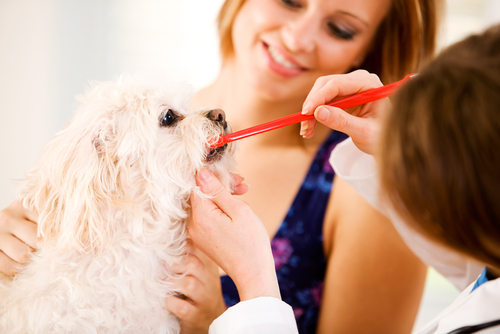How to Brush My Pet's Teeth

Looking after your pet's teeth is one of many responsibilities that you adopt when you become the caring and responsible owner of a brand new furbaby.
One of the best ways to do this, and to help your pet retain healthy teeth for as long as possible, is to brush them regularly.
Why brushing is important
You could be forgiven for thinking that teeth brushing is a purely human endeavour. While is it much easier for us, since we can do it for ourselves, regular brushing can be equally as beneficial for the furrier members of your family. This is because brushing is the best way to remove the food particles that eventually form plaque, and then tartar, on our pet's teeth. If this happens, decay and periodontal disease, which is the most prevalent condition among dogs and cats, is inevitable. However, by brushing our pet's teeth and ensuring they get the best dental care possible, we can protect them from debilitating dental and general health problems and even help them live longer.
What equipment do I need to brush my pet's teeth?
Before you can think about starting to brush your pet's teeth, you first need to get the right equipment in place. This means:
A toothbrush choose a small-headed brush with soft bristles. If they are too hard, they could damage the enamel on your pet's teeth and cause their gums to recede. If you don't have a specially-designed pet toothbrush, a human child-sized version will work just fine.
Pet toothpaste human toothpaste is toxic to pets and should never be used. Pet varieties come in flavors that will appeal to your furbaby, such as malt or chicken.
Brushing techniques
Once you have the necessary tools for teeth brushing, get your pet in a calm, relaxed mood and you can begin the brushing process. Ideally you will want to work this into your daily routine, so choose a time which is likely to be the most convenient for day to day brushing, such as before bed.
- Get in position and check her tolerance to having her teeth touched
You need to find a position that isn't threatening to your pet, but also allows you good access to her teeth. Try kneeling or sitting either in front or next to her, as this allows her to see you and what you are doing, which will help ease any anxiety she may feel. Once you are both in position you should test if she is comfortable having her mouth touched. You can do this by lightly rubbing your finger along her teeth and upper gums. If this is the first time you have brushed her teeth, she may need a few sessions that last just until this point to get her used to the idea of her gums and teeth being touched.
- Introduce her to the toothpaste
Once your furbaby is used to letting you touch her teeth, the next thing to do is to get her used to her new toothpaste. The best way to do this is to squeeze a little onto your fingertip and let her lick it off! If she likes it, she will hopefully view it as a special treat and this will get her used to the smell, texture and taste of the toothpaste. There are several different flavors available, so if she seems put off by the first one you offer, try a different flavour.
- See if she is receptive to brushing
If she lets you touch her teeth and gums, and is happy with the flavour of the toothpaste, it is time to start trying to brush her teeth. Load the brush with a little of the paste, then lift her upper lip and place the brush against her teeth at a 45-degree angle. Plaque tends to accumulate along the gum line, and this is the best angle for clearing debris and bacteria away. You may need to start with just brushing a few teeth at a time and build up to the recommended two minutes.
If she is receptive to brushing, use small, circular motions to clean her teeth. Move along the upper and then lower teeth methodically, placing particular attention to the area where the teeth meet the gums. Always start with the teeth in the upper jaw, as bacteria and debris may fall on to the teeth in the lower mandible.
- Reassure and reward her
For every positive behavior exhibited by your furbaby in the brushing process, reward her with lots of love and praise. Keep the mood light and reassure her throughout. If you have a great bond, she will trust that you will not put her in any danger or hurt her by brushing her teeth.
Don't forget - while brushing your pet's teeth is a crucial part of her dental care, you should still take her for her regular dental check-ups with our veterinarian! Contact Charlotte Animal Hospital for further advice.

